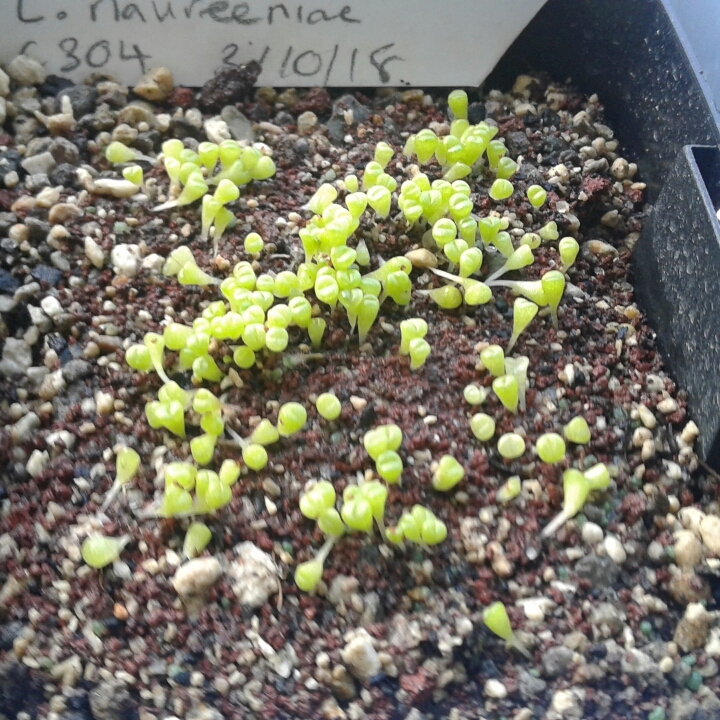
Lithops Naureeniae
Living Stones 'Naureeniae'
Original:Description: Lithops naureeniae is a robust species with distinctive pink to pale reddish-brown bodies which are curiously punctuate with dark star-shaped patterns forming a marbled effect design. It is however rather variable, with a character which cannot be easily defined; distinguished mainly by its divergent profile and usually fairly bold islands. In autumn it produces bright yellow flowers with white centre.Similar species: L. naureeniae is closely related, and very similar to Lithops helmutii. Habit: It is an acaulescent perennial, geophytic, succulent, seldom solitary, forming small or large clumps mostly of 2-5 head up to 1 cm high, occasionally with up to 28 or more heads.Bodies (Paired leaves): Small to medium sized, compact, 20-35 mm long, 8-25 mm broad, leaves bicuneate-cordate in profile, deeply fissured, lobes slightly to widely divergent, sometimes with one side of the face lower than the other. Apex profile more or less convex, smooth, slightly elevated, mostly elongated elliptic. Margins distinct, narrow, some-times toothed with numerous peninsulas grey or beige. Islands irregular, few to many, small to large, sometimes reduced to flecks, pale grey or beige often taking a purple tinge under stress. Windows more or less open greyish-green, greenish, brownish or reddish grey. Channels narrow to broad, irregular,greyish green or greenish, brownish or reddish grey. Rubrication absent. Shoulders and inner faces of fissures and margins, dark-greyFlowers: Daisy-like, diurnal, 20-35 mm. in diameter, shining golden yellow with a white heart.Blooming season: Late autumn. Lithops naureeniae along with Lithops olivacea are the last of the yellow-bloomer Lithops to flower.Fruit: Capsules 5-6-chambered, profile boat-shaped, top flat to slightly convex, faces almost round.Seeds: Yellow-brown.Collapse... New:A popular and sought after succulent. Lithops have paired leaves with smooth flat or rounded tops that are ridged or wrinkled, sometimes with transparent windows, and sometimes colorful markings. The flowers are white or yellow and emerge in autumn or winter. Lithops are relatively easy to grow if given sufficient sun and a suitable well-drained soil.
-
Full sun to partial shade
-
Very little water
-
Not Frost hardy
-
Light and free draining
Common name
Living Stones 'Naureeniae'
Latin name
Lithops Naureeniae
type
Succulent
family
Aizoaceae
ph
5.0 - 6.5 Acid - Neutral
Plant & bloom calendar
-
Best time to plant
full grown dimensions
 0.02 M
0.01 M
0.02 M
0.01 M
Lithops Naureeniae
Original:Description: Lithops naureeniae is a robust species with distinctive pink to pale reddish-brown bodies which are curiously punctuate with dark star-shaped patterns forming a marbled effect design. It is however rather variable, with a character which cannot be easily defined; distinguished mainly by its divergent profile and usually fairly bold islands. In autumn it produces bright yellow flowers with white centre.Similar species: L. naureeniae is closely related, and very similar to Lithops helmutii. Habit: It is an acaulescent perennial, geophytic, succulent, seldom solitary, forming small or large clumps mostly of 2-5 head up to 1 cm high, occasionally with up to 28 or more heads.Bodies (Paired leaves): Small to medium sized, compact, 20-35 mm long, 8-25 mm broad, leaves bicuneate-cordate in profile, deeply fissured, lobes slightly to widely divergent, sometimes with one side of the face lower than the other. Apex profile more or less convex, smooth, slightly elevated, mostly elongated elliptic. Margins distinct, narrow, some-times toothed with numerous peninsulas grey or beige. Islands irregular, few to many, small to large, sometimes reduced to flecks, pale grey or beige often taking a purple tinge under stress. Windows more or less open greyish-green, greenish, brownish or reddish grey. Channels narrow to broad, irregular,greyish green or greenish, brownish or reddish grey. Rubrication absent. Shoulders and inner faces of fissures and margins, dark-greyFlowers: Daisy-like, diurnal, 20-35 mm. in diameter, shining golden yellow with a white heart.Blooming season: Late autumn. Lithops naureeniae along with Lithops olivacea are the last of the yellow-bloomer Lithops to flower.Fruit: Capsules 5-6-chambered, profile boat-shaped, top flat to slightly convex, faces almost round.Seeds: Yellow-brown.Collapse... New:A popular and sought after succulent. Lithops have paired leaves with smooth flat or rounded tops that are ridged or wrinkled, sometimes with transparent windows, and sometimes colorful markings. The flowers are white or yellow and emerge in autumn or winter. Lithops are relatively easy to grow if given sufficient sun and a suitable well-drained soil.
Planting
From Early Spring TO Early Spring
Lithops thrive best in a coarse, well-drained substrate. Any soil that retains too much water will cause the plants to burst their skins as they over-expand. Plants grown in strong light will develop hard strongly coloured skins which are resistant to damage and rot, although persistent overwatering will still be fatal. Excessive heat will kill potted plants as they cannot cool themselves by transpiration and rely on staying buried in cool soil below the surface.
Propagation
From Early Spring TO Early Spring
Propagation of Lithops is by seed or cuttings. Cuttings can only be used to produce new plants after a plant has naturally divided to form multiple heads, so most propagation is by seed. Lithops can readily be pollinated by hand if two separate clones of a species flower at the same time, and seed will be ripe about 9 months later. Seed is easy to germinate, but the seedlings are small and vulnerable for the first year or two, and will not flower until at least two or three years old.








